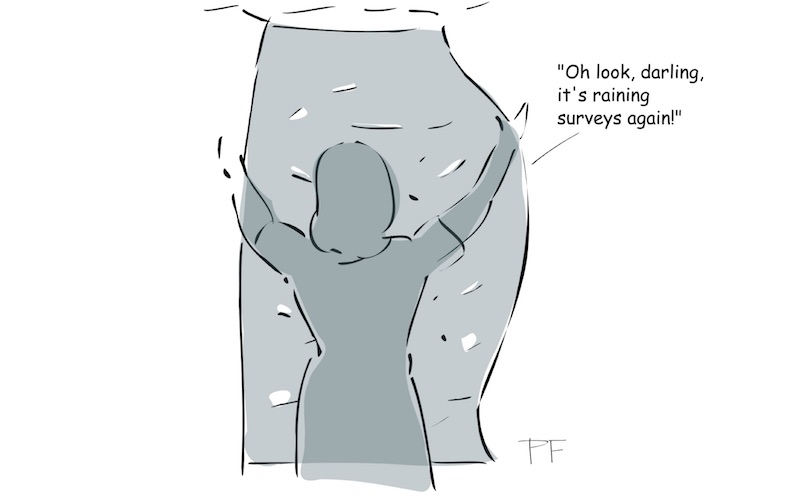Improving response rates to survey requests sent by email
Way back in October last year I blogged about using direct marketing techniques to improve response rates to surveys. (You can find that blog here.) I would like to add some points that are specifically about survey requests sent by email. Here are five things you can do, in priority sequence. If you have other ideas, I would love to hear about them.
Let people start to respond to the survey directly in the email
By far the most important thing you can do is allow respondents to respond to the survey directly in the email they receive. Unfortunately, this is technically difficult. The best you can do is to embed the first question in the email, usually the overall rating question. Use HTML widgets to do this. They do not get blocked by the common email clients at least at the time this is written. Embedding the first question improves response rates by a factor of 2.5x, in my personal experience. Promoter.io and other software providers have found that it triples response rates. My suspicion is that embedding the first question makes it far less likely that people believe the survey link could be a phishing attack or other security risk.
Tell everyone what you have learned
Provide feedback to everyone, not just the respondents. When you have completed the survey and determined the actions, write back to the entire mailing list to let them know their voices have been heard and telling them what you are going to do. Those who did not respond are more likely to answer the next time, and could also be given a way of adding their voices immediately if they do not feel represented.
High-quality contact lists
Ensure you have an email contact list that you maintain and use regularly for customer communications. That has two main benefits, one obvious and one less so. First, you will have far fewer emails ‘bounce’ due to unknown addresses. The second benefit is that customers who read your emails will almost certainly have authorized the displaying of ‘pictures’ for anything received from your email domain. Outlook and other clients default to blocking pictures from unknown sources. You should minimize the use of pictures and other graphics in outbound emails in any case, as they present consistency challenges across phone, tablet and PC platforms. One good aspect of the new European Union General Data Protection Regulation is that email lists that respect the new rules will be of high quality, though the lists may be somewhat shorter than ones you would have had before.
Test your outbound emails
Test your outbound email with a set of internal users first, to detect problems. Send some additional test emails to internal users from a non-company email address, to see how they display if an email client blocks anything or automatically puts the email in a spam folder.
Thank people in advance for their help
While I have suggested not using strong incentives, simply thanking people in advance, promising to act and to inform them of the results should be a sufficient incentive for many, and should have a positive effect on response rates.
That’s it for the response rate improvement suggestions. Now let’s discuss ‘over-surveying’.
Risk of over-surveying
How do you know whether you are over-surveying? There are two main principles. First, you need to provide more value than you extract, which should push you towards short surveys. Second, you need to be planning to act on the feedback, including informing customers about your progress. Remember that over-surveying is about individuals, not companies. It does not matter if you send surveys to multiple people in a company. What you want to avoid is sending one individual multiple surveys in a short period of time. When thinking of this, bear in mind that your competitors may be sending surveys to the same person too.
Over-surveying may be over-rated as a problem
Let’s face it, if a customer has not responded to your survey request, they have not wasted any time, but you do not know what they are thinking. Most transactional surveys will give you a response rate between 5 and 15%. Product survey response rates can be a little higher. The people you need to avoid asking to respond again in a short period of time are those who already answered your survey. Most of your customers will not have answered. These should be the focus for the following research round, assuming it happens reasonably soon after the previous one. Write something that starts like this:
“Dear Mrs. Smith,
I realize you did not have time to respond to my request to help us improve our product when I wrote to you six weeks ago. The people who did answer helped us to determine the two items below as our top two improvement priorities. I really want to have a third project and would like to once again ask for your help. There are just three questions and this won’t take you more than about 3 minutes…”
Taking this approach improves the overall response rate, and therefore improves reliability. Make sure you don’t send these emails to people who have already answered.
More generally
If you have listened to customers, made improvements, then reported the progress back to customers, you cannot be accused of over-surveying if you start the process again. Customers will be able to see that you have provided at least as much value as you have extracted, and will cooperate. It is important to communicate your progress to all customers, not just those who responded.
[Like the majority of my blog posts, this one is a mildly-edited version of a chapter in one of our books, in this case Net Promoter – Implement the System.]



